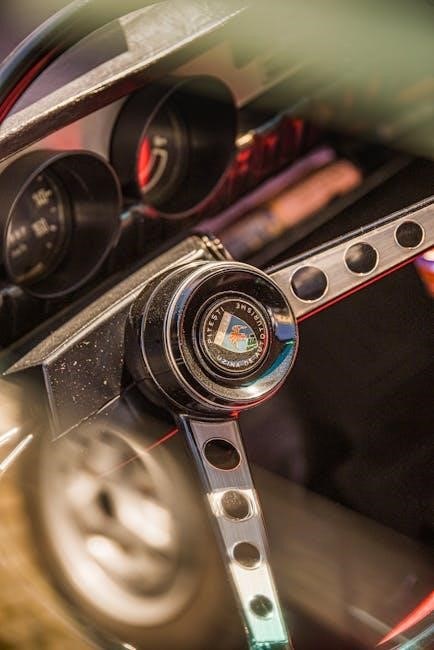Manual steering is a system that relies on mechanical components to control vehicle direction without electric assistance. It provides direct driver control and is valued for its simplicity, durability, and connection to the road, making it a preferred choice for driving enthusiasts and specific vehicle applications.
1.1 Definition and Purpose of Manual Steering
Manual steering is a system that relies on mechanical components to control a vehicle’s direction without electric assistance. Its primary purpose is to provide direct driver control, ensuring simplicity, reliability, and cost-effectiveness. It is particularly valued in racing and classic cars for its tactile feedback and mechanical connection to the road.
1.2 Historical Background of Manual Steering Systems
Manual steering systems trace their origins to the early 20th century, evolving from basic mechanisms in horse-drawn carriages. Over time, innovations like the steering wheel and gearbox improved functionality. Initially, all vehicles used manual steering, which remained predominant until the advent of power steering in the mid-20th century, offering enhanced convenience.
1.3 Advantages of Manual Steering Over Power Steering
Manual steering offers superior road feel, direct control, and mechanical simplicity. It requires less maintenance and is lighter, improving fuel efficiency. Drivers often prefer it for precision in sports and vintage cars, where the connection to the vehicle enhances the driving experience and skill development.

How Manual Steering Works
Manual steering operates through mechanical components, converting the driver’s wheel rotation into vehicle direction. It relies on a steering shaft, gearbox, and rack to translate motion without power aid.
2.1 Mechanical Components of a Manual Steering System
A manual steering system comprises a steering wheel, steering shaft, universal joints, gearbox, and tie rods. These components work together to mechanically transmit the driver’s input to the vehicle’s wheels, enabling precise control without electronic assistance, ensuring reliability and direct feedback.
2.2 Steering Geometry and Alignment
Steering geometry and alignment are critical for vehicle stability and handling. Proper alignment ensures wheels are angled correctly, optimizing traction and reducing wear. Key factors include camber, caster, and toe, which influence how wheels contact the road. Accurate alignment enhances control and responsiveness, particularly in manual steering systems where driver input is direct.
2.3 The Role of Steering Ratio in Manual Systems
The steering ratio determines how much the front wheels turn relative to the steering wheel input. A lower ratio requires less wheel movement for tighter turns, enhancing maneuverability, while a higher ratio provides stability at higher speeds. This balance is crucial for precise control and driver effort in manual steering systems.
Maintenance and Repair of Manual Steering
Regular lubrication, inspecting components for wear, and addressing alignment issues are key to maintaining manual steering systems. Prompt repairs prevent major failures and ensure optimal performance.
3.1 Tips for Maintaining Manual Steering Systems
Regularly check and lubricate steering components to reduce friction and wear. Inspect for loose connections and worn parts. Maintain proper tire pressure and alignment. Address any play in the steering immediately to prevent further damage. Keep the system clean and free from debris for smooth operation and longevity.
3.2 Common Issues and Troubleshooting
Common issues include excessive play, tight steering, and noise. Check and tighten loose connections. Lubricate moving parts. Inspect for worn components like tie rods or ball joints. Bleeding the system can resolve air pockets causing resistance. Professional alignment may be needed for persistent problems to ensure proper vehicle handling and safety.
3.3 DIY Repairs vs. Professional Assistance
DIY repairs are cost-effective for minor issues like lubrication or tightening connections. However, complex problems such as replacing steering gears or racks often require specialized tools and expertise. Professional mechanics ensure precise adjustments and safety, preventing further damage. Balancing DIY efforts with professional help is key for optimal results and long-term reliability;

Manual Steering vs. Power Steering
Manual steering offers direct control and feedback, requiring physical effort. Power steering provides ease and reduced effort, especially in low-speed maneuvers, enhancing comfort and accessibility for drivers.
4.1 Key Differences Between the Two Systems
Manual steering relies on physical effort and mechanical components for control, offering direct road feedback. Power steering uses hydraulic or electric assistance, reducing effort, especially at low speeds. Manual systems are simpler, more durable, and require less maintenance, while power steering enhances comfort and accessibility for drivers in various conditions.
4.2 When to Choose Manual Steering
Manual steering is ideal for lightweight vehicles, racing, and classic cars where precise control and feedback are crucial. It’s also suited for drivers who prefer a connected driving experience and for applications where simplicity and reliability are prioritized over ease of use.
4.3 Performance Comparison in Various Driving Conditions
Manual steering excels in city driving due to its precise control and responsiveness. On highways, it offers stability and consistent handling. In tight spaces, it requires more effort but provides better accuracy. For rough roads, manual systems can be less forgiving but maintain direct feedback, making them suitable for drivers seeking a more engaging experience.

Safety Considerations with Manual Steering
Manual steering requires physical effort, increasing driver fatigue on long drives. It demands constant alertness and strength, making it less safe for inexperienced drivers in challenging conditions.
5.1 Driver Fatigue and Manual Steering
Manual steering demands consistent physical effort, leading to driver fatigue, especially in slow-moving traffic or during repetitive maneuvers. This can reduce reaction times and impair driving accuracy, posing safety risks. Regular breaks and maintaining proper driving posture are essential to mitigate fatigue while operating vehicles with manual steering systems.
5.2 Safety Tips for Driving with Manual Steering
When driving with manual steering, maintain a firm grip on the wheel and keep both hands in the 3-o’clock and 9-o’clock positions for better control. Use slow, deliberate movements to avoid jerky steering. Ensure proper vehicle maintenance, including tire pressure and alignment, to enhance stability and reduce driver strain on the road.
5.3 Emergency Procedures for Manual Steering Failures
In case of manual steering failure, remain calm and gently slow down. Avoid sudden movements, as this can worsen control loss. Steer carefully toward the roadside, brake gradually, and pull over safely. Engage the parking brake and seek professional assistance immediately to prevent accidents and ensure proper repairs.
The Future of Manual Steering
Manual steering is evolving with advancements in technology, integrating sustainable materials and smart systems while maintaining its core mechanical simplicity and driver connection.
6.1 Technological Advancements in Manual Steering
Manual steering is embracing innovation through advanced materials, AI-driven systems, and smart manufacturing. These technologies enhance efficiency, reduce weight, and improve precision while maintaining the system’s mechanical integrity and driver engagement.
6.2 Integration with Autonomous Driving Systems
Manual steering systems are being integrated with autonomous technologies, offering hybrid solutions that combine driver control with AI-assisted features. This blend enhances safety and convenience while preserving the tactile experience, creating a balanced approach for future mobility.
6.3 The Role of AI in Enhancing Manual Steering
AI enhances manual steering by offering real-time feedback, adaptive adjustments, and predictive maintenance. Through advanced algorithms, AI optimizes steering performance, reducing driver fatigue and improving precision, thus modernizing traditional systems without compromising their core mechanical advantages.
Learning to Drive with Manual Steering
Mastering manual steering requires practice, coordination, and muscle memory. It enhances driving precision and control, making it a valuable skill for both new and experienced drivers.
7.1 Benefits of Learning Manual Steering
Learning manual steering improves driver engagement, enhances control, and boosts situational awareness. It fosters better mechanical understanding, reduces reliance on automation, and is often preferred in racing and classic vehicles. Additionally, it can lower maintenance costs and increase fuel efficiency in certain driving conditions.
7.2 Tips for Beginners to Master Manual Steering
Beginners should practice in open spaces to build muscle memory. Use smooth, gradual turns and avoid jerky movements. Keep hands positioned at 9 and 3 o’clock for optimal control. Start with low speeds to understand steering resistance and gradually increase as confidence grows.
7.3 Common Mistakes to Avoid
Beginners often make jerky steering inputs and overcorrect, causing instability. Another mistake is gripping the wheel too tightly, reducing sensitivity. Additionally, neglecting to check tire pressure and alignment can lead to poor handling. Avoid sudden turns at high speeds to maintain control and ensure smooth driving experiences.

Troubleshooting Common Manual Steering Issues
Troubleshooting manual steering involves identifying and diagnosing problems such as loose components, worn gears, or misalignment. Regular inspections and timely repairs are essential for optimal performance and safety.
8.1 Identifying and Diagnosing Problems
Identifying issues in manual steering starts with observing symptoms like stiffness, vibrations, or unusual noises. Inspecting components such as the steering rack, tie rods, and fluid levels can help pinpoint problems. Diagnostic tools and visual checks aid in determining the root cause, ensuring accurate repairs and maintaining system functionality. Regular maintenance is key to prevention.
8.2 Solutions for Worn or Loose Components
Replace worn parts like tie rods or ball joints immediately to ensure safety. Tighten loose connections and lubricate moving components regularly. Inspect for wear and tear during maintenance to prevent further damage. Addressing these issues promptly enhances steering precision and overall vehicle stability, avoiding costly repairs down the line.
8.3 Adjusting Steering Play and Alignment
Adjusting steering play involves tightening loose components and aligning wheels properly. Use specialized tools to ensure precise alignment, reducing tire wear and improving handling. Regular checks prevent misalignment caused by potholes or accidents, ensuring smooth control and enhanced safety on the road for manual steering systems.

Environmental Impact of Manual Steering
Manual steering systems reduce energy consumption and emissions by eliminating power steering’s electrical demand. Their simplicity lowers production resources and waste, contributing to a more sustainable automotive solution.
9.1 Fuel Efficiency and Emissions
Manual steering enhances fuel efficiency by avoiding the energy consumption of power steering systems. This reduction in electrical load decreases emissions, making manual steering a more environmentally friendly option for drivers seeking to minimize their carbon footprint while maintaining vehicle performance and control.
9.2 Eco-Friendly Alternatives to Manual Steering
Eco-friendly alternatives to manual steering include electric power steering systems, which reduce fuel consumption and emissions. Additionally, regenerative braking systems and hybrid powertrains further enhance environmental benefits, offering drivers sustainable options that align with modern eco-conscious driving practices without compromising steering performance or control.
9.3 Sustainability of Manual Steering Systems
Manual steering systems are inherently sustainable due to their simplicity, requiring fewer resources and energy for production. With no reliance on electricity or complex components, they minimize environmental impact. Their longevity and ease of repair further contribute to sustainability, reducing electronic waste and the carbon footprint associated with frequent replacements.

Cost Considerations
Manual steering systems offer lower purchase and maintenance costs due to their simple mechanics and higher fuel efficiency, providing long-term savings for drivers.
10.1 Purchase and Maintenance Costs
Manual steering systems typically have lower upfront costs and require less maintenance compared to power steering. They involve fewer complex components, reducing repair expenses and extending system longevity. This simplicity translates to long-term financial benefits for vehicle owners, making manual steering a cost-effective option for many drivers.
10.2 Long-Term Savings with Manual Steering
Manual steering systems offer significant long-term savings due to reduced energy consumption and lower maintenance needs. They eliminate the cost of power steering components like pumps and hoses, minimizing repair expenses. Additionally, their simplicity reduces the risk of costly failures, making them a financially prudent choice for drivers seeking durability and reliability.
10.3 Budgeting for Repairs and Upgrades
Budgeting for manual steering repairs involves allocating funds for components like gears and seals, which may wear out over time. Regular maintenance costs, such as lubrication and alignment checks, should also be considered. Upgrades, like replacing the steering box or linkage, can enhance performance but require a larger upfront investment.

Case Studies and Real-World Applications
Manual steering is widely used in racing cars for precision, industrial vehicles for durability, and classic cars for nostalgic driving experiences, showcasing its versatility and enduring value.
11.1 Manual Steering in Racing and Sports Cars
In racing and sports cars, manual steering systems are preferred for their precise control and direct feedback, allowing drivers to make quick, accurate turns essential for competitive performance. The absence of power assistance enhances the connection between driver and vehicle, making it a key feature in high-performance applications where responsiveness is critical.
11.2 Use of Manual Steering in Industrial Vehicles
Manual steering is commonly used in industrial vehicles due to its simplicity and durability. These systems require less maintenance and are cost-effective, making them ideal for rugged environments. They provide precise control, essential for handling heavy loads and navigating challenging terrains efficiently, reliability in continuous operations.
11.3 Manual Steering in Classic and Vintage Cars
Manual steering is often preferred in classic and vintage cars for its nostalgic driving experience. These systems emphasize a direct mechanical connection, offering simplicity and durability. Enthusiasts value the hands-on control and tactile feedback, making manual steering a cherished feature in preserving the authentic character of vintage vehicles.
Manual steering remains a timeless and essential system, offering simplicity, driver connection, and reliability. Its niche in classic cars and specific driving conditions ensures its enduring relevance and appeal.
12.1 Summary of Key Points
Manual steering systems offer simplicity, durability, and a direct driving experience. They require physical effort but provide better control and feedback, making them ideal for specific vehicles and driving conditions. Their mechanical nature ensures reliability and minimal maintenance, appealing to enthusiasts and classic car owners alike;
12;2 Future Prospects for Manual Steering
Manual steering, though traditional, can evolve with AI integration, offering adaptive feedback and predictive adjustments. This fusion enhances driving efficiency while maintaining the mechanical simplicity cherished by enthusiasts. The system’s reliability ensures its continued relevance in niche automotive markets and as a fallback in autonomous vehicles.
12.3 Final Thoughts on the Importance of Manual Steering
Manual steering remains vital for its tactile feedback and direct driver engagement. It fosters a deeper connection between driver and vehicle, enhances control in specific driving conditions, and preserves traditional driving skills. Its simplicity and reliability ensure its continued relevance in maintaining automotive heritage and driving excellence.
